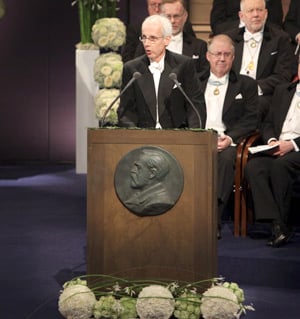Award ceremony speech
Presentation Speech by Professor Rune Toftgård, Member of the Nobel Assembly at Karolinska Institutet, 10 December 2009
 |
| Professor Rune Toftgård delivering the Presentation Speech for the 2009 Nobel Prize in Physiology or Medicine at the Stockholm Concert Hall. Copyright © The Nobel Foundation 2009 Photo: Frida Westholm |
Your Majesties, Your Royal Highnesses, Ladies and Gentlemen,
Every human being, with all the different cell types and tissues, develops from a single fertilised egg cell by means of repeated cell divisions. The structural map found inside our genetic material is copied in its entirety before each cell division. Each cell needs to carry the complete map inside it.
By the mid-20th century, it was clear that genetic material is made up of DNA strands inside the cell nucleus. These DNA strands are packed into chromosomes, numbering 46 in humans. Two past Nobel Laureates, Hermann Muller and Barbara McClintock, long ago observed that the ends of the chromosomes, which Muller named the telomeres, were special and particularly stable. One unanswered question was: In what way were these telomeres different, and what was their actual function?
Another question: How can telomeres be fully copied? Based on the knowledge that was available in the late 1970s, the DNA in chromosomes should become shorter each time a cell divided. But this is not what actually happens.
The first question − about the function of the telomeres − was answered after Elizabeth Blackburn and Jack Szostak met at a scientific conference in 1980 and began their research collaboration. In a pioneering experiment, they demonstrated that telomere DNA from one organism, a unicellular ciliated protozoan called Tetrahymena thermophila, would protect and stabilise chromosomes in an entirely different organism, yeast. The natural chromosomes in yeast cells were also shown to contain similar DNA sequences with the same function. Today we know that the protective function of telomeres is strongly conserved in the evolutionary chain and is present in all higher organisms, including us humans.
The second question − how telomere DNA could be formed and avoid becoming shorter each time a cell divided − was answered in an elegant way by Elizabeth Blackburn and Carol Greider. They discovered an enzyme that can produce telomere DNA. The very first proof that this enzyme existed came as a fantastic Christmas present, on Christmas Day 1984. The enzyme was given the name telomerase. It turned out to be unique in its structure and to consist of an enzymatically active protein component plus an RNA component that serves as a template for the formation of new telomere DNA.
Knowledge of telomeres and telomerase has led to important medical insights in many different fields.
One group of rare congenital diseases is caused by mutations that impair the functioning of telomerase. These diseases are characterised by bone marrow defects that result in reduced formation of new blood cells and can now be diagnosed with certainty.
If telomeres are not preserved, eventually cells cannot survive. Telomere shortening is thus one of several factors that affect the ageing process. In contrast, cancer cells can divide endlessly and nearly all of them have elevated telomerase activity. There is consequently hope that new drugs which target telomerase can be developed to fight cancer, and a number of clinical trials are under way.
The discovery of the vital role of telomeres in preserving chromosomal and genetic stability was made through research driven by curiosity and aided by simple model organisms. The findings of this research have provided fundamental insights into human biology and disease mechanisms.
Professors Blackburn, Greider and Szostak:
Your discoveries have revealed how the conserved function of telomere repeat sequences can maintain chromosomal and genetic stability and how synthesis of telomere DNA is achieved by the enzyme telomerase. In this way you have solved a long-standing and fundamental problem in biology, provided insight into disease mechanisms and raised hope that new therapies can be developed by targeting telomerase.
Today, the one hundredth Nobel Prize in Physiology or Medicine is being awarded. On behalf of the Nobel Assembly at Karolinska Institutet, it is my great privilege to convey to you our warmest congratulations. I now ask you to step forward to receive your Nobel Prizes from the hands of His Majesty the King.
Nobel Prizes and laureates
Six prizes were awarded for achievements that have conferred the greatest benefit to humankind. The 14 laureates' work and discoveries range from quantum tunnelling to promoting democratic rights.
See them all presented here.
